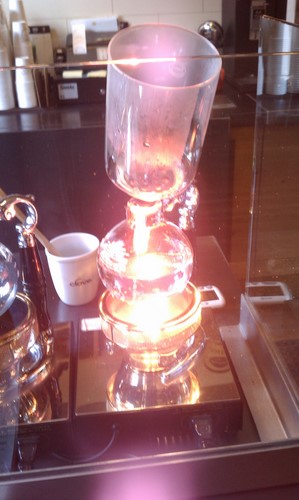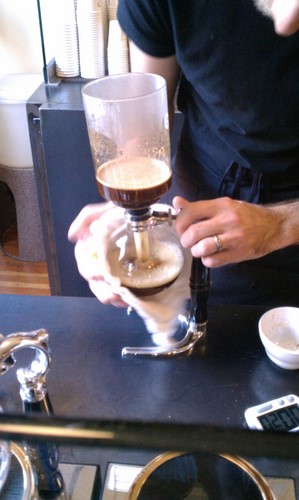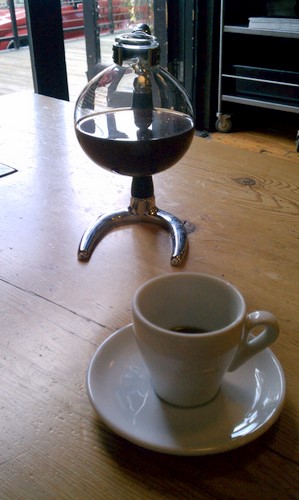When you read what I did yesterday, you might want to ask me: Are you f---ing nuts? Believe me, I asked myself that question more than once. What did I do? I’m almost ashamed to admit it, but I spent $9 on a cup of coffee (12oz). No, that’s not a misprint. I promised a reader (Jake) that I would write about the vacuum pot, or siphon method of brewing coffee. I knew that Barista in the Pearl District had them, so I went there on a mission—seek out a vacuum pot and report on its mysterious powers. Then I got there and saw the price. It almost made me cry, but I had made a promise. . .
What is so special about the siphon brewing method? Well, for one thing, it’s great coffee theater. A vacuum pot looks cool—almost space-aged, even though it has been around for nearly 150 years! You don’t see them in use very much, so when you do get to see one it is worth watching. I stood there captivated as the barista prepared my precious coffee, an Ethiopia Sidama from Intelligentsia.
This is how the siphon method works: First, the barista measures out the correct amount of water into the lower bulb of the vacuum pot. The bulb is then placed over a heat source. It could be a flame or a hot plate, but at Barista, they have specially-designed heat lamps that heat the water (it looks cooler that way). While the water is heating, the barista then measures out and grinds the proper amount of coffee, setting it aside until the water is ready.
 Warming up
Warming up
When the water begins to boil, steam travels up a tube, condensing back into water as it travels upward. When it reaches the bowl on top, the water is about 202 F, just the right temperature for coffee extraction. When nearly all the water has reached the bowl, the barista adds the ground coffee and stirs it, making sure that the all of the grounds are in contact with the water. While the extraction is taking place, the small amount of water in the bottom bulb continues to rise into the extraction chamber, helping maintain a constant temperature. The coffee is allowed to brew for two to four minutes, depending on the grind.
At Barista, they grind the coffee a little finer than at some places and only brew the coffee for two minutes. The barista explained that the faster extraction gives the coffee better flavor, and helps it retain more of its natural sweetness. When the time is up, the vacuum pot is pulled off the heat source and the lower bulb begins to cool, creating a vacuum that pulls the brewed coffee down through the cloth filter and into the serving pot. Barista’s baristas even hold a frozen towel against the lower bulb to strengthen the vacuum and pull the coffee back through the filter more quickly. They are very careful to prevent over-extraction.
 Cooling down
Cooling down
How would I describe the coffee that they served me? It had a very different mouth feel from any other coffee I had ever tasted. It left a pleasant sensation in my mouth almost like tea does. The coffee was very tangy—I thought I could taste green apples or under-ripe blackberries in it. The reason that a vacuum pot has such “pure” flavors is that all of the grounds are fully immersed and the temperature remains constant throughout the duration of the brewing process. Therefore, you are getting the full flavor of the coffee. Other methods like the pour-over or French press are not as constant with the immersion or temperature.
 Ready to savor
Ready to savor
The vacuum pot creates a clean cup of coffee because the cloth filter is very effective at removing the grounds from the water. Some people do not like French press coffee specifically because some of the grinds are likely to get through the mesh filter used to make the coffee. In my coffee, there was absolutely no trace of grinds in the server or cup.
Would I recommend getting a vacuum pot? If you like brewed coffee, you would probably love siphon coffee. The method preserves the brightness and complex flavors of the coffee. You can’t get a cleaner, brighter cup of coffee and it’s a good show to watch your barista prepare it. If you prefer espresso to brewed coffee, however, you might not think it’s worth it.
I will say though—without any doubt—that it was the best $9 cup of coffee I’ve ever had. It might be the last, too, at least until someone offers to take me out for some siphoned coffee. For that kind of money, I can get more enjoyment out of several different espressos.